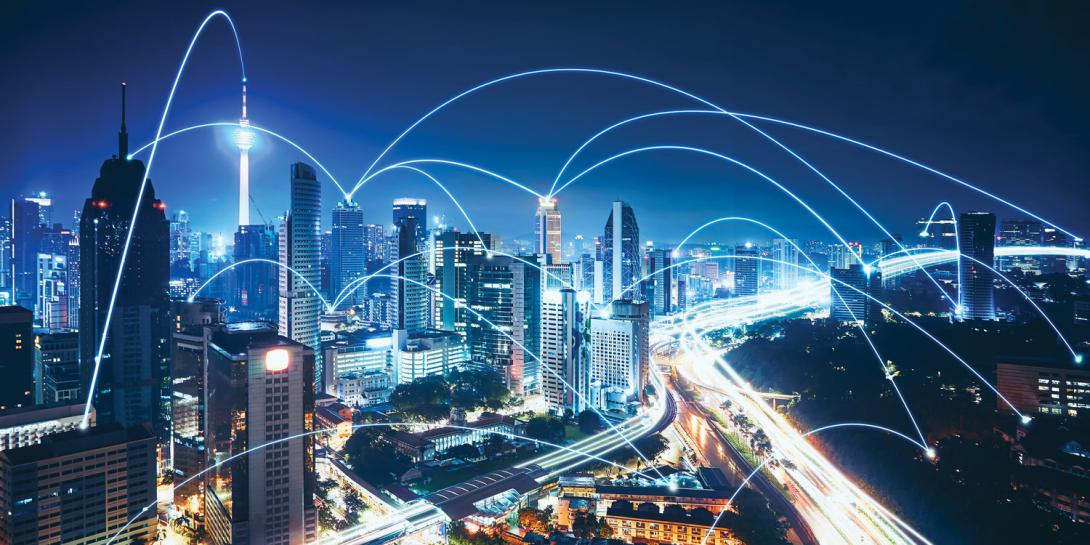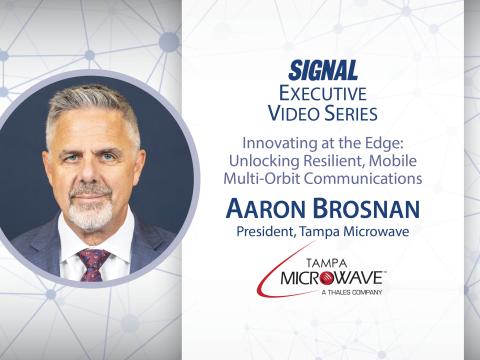5G for Warfighters
News about the coming 5G wireless network is seemingly everywhere, with advertisements referring to it as revolutionary or transformational. And indeed, the suggested “superpowers” of the fifth generation of wireless technology are quite impressive: great speed, improved latency and tremendous capacity in terms of bandwidth. 5G will provide connectivity to many more devices, support video and other digital images at much higher capacities and broaden the era of the Internet of Things. 5G will become the basis for critical infrastructure and the platform that enables the use of autonomous vehicles, which will alter daily life.
U.S. carriers are in the process of building out their mobile 5G networks in cities across the nation, and within two years, the 5G network will be widespread.
Experts warn, however, that the U.S. network will only be available in the continental states and that it is designed for consumers in large cities—not the military. For warfighters to harness the network, more innovation, thought and policies are necessary.
Recent AFCEA conferences and other corporate events have featured industry experts discussing what warfighters can expect from 5G, including: Xavier Williams, president, AT&T Public Sector; Andre Fuetsch, president, AT&T Labs and Chief Technology Officer, AT&T; Chris Smith, vice president, Technology, AT&T Public Sector; Maj. Gen. Robert Wheeler, USAF (Ret.), CEO, Strategic Consulting Unlimited LLC; and Nick Nilan, director, Product Development, Public Sector, Verizon. SIGNAL also spoke with the Army’s former Program Executive Office Command Control and Communications–Tactical (PEO C3T) Gary Martin.
5G essentially comprises two elements. First, it provides an upgrade of 4G equipment. In some cases, 5G will not necessarily replace 4G; it will work in conjunction with it, the experts say. 5G also ushers in millimeter wave communications. The various carriers will be offering different spectrum options in 5G, some in the middle of millimeter wave and some in the traditional spectrum ranges, Verizon’s Nilan says.
He clarifies that the telecommunications marketing term for 5G is ultra-wide band, but for those in spectrum management, this really is millimeter wave. However, one of the drawbacks of millimeter wave is that it has less of a range and requires more infrastructure. “Right now we propagate most of our spectrum on 4G at 700 megahertz, which is fantastic for really far distances, three to five miles from a macro cell,” Nilan explains. “Millimeter wave spectrum is going to be much more condensed, much closer to the tower. So you’re going to need a lot more towers, a lot more small cells to get 5G where you want to go, but the benefit of that is bandwidth.”
When Verizon started bidding on spectrum for 4G back in 2007, essentially, they “bought roughly 20 lanes of highway across the entire country, and our biggest competitor did too,” Nilan states. Over the years, Verizon built that communications highway up to 100 to 120 lanes. With 5G, however, the company’s spectrum at 28 and 39 gigahertz opens up 800 megahertz of spectrum—800 lanes of highway—across the country, he emphasizes. Carrier aggregation allows the company to move data traffic on that highway as needed, which creates better security and efficiency on the network. “That’s what 5G ultra-wide band is going to do,” he offers. “You can imagine what you could do in a city, what you can do in a factory or what you can do on a battlefield. It’s almost endless.”
For AT&T’s Williams, “There is a lot to look forward to when it comes to 5G and the immense potential it holds.” 5G will change how the United States defends the homeland. It will strengthen smart military bases and enhance telemedicine, citizen engagement, school safety, voting registration, census taking and public works, among other things, he portends.
AT&T has invested $145 billion in their wireless and wired networks since 2013. Now the company is focusing on software-defined networking and an open source network operating system as part of its platform that will provide mobile 5G, fixed wireless and edge computing capabilities.
Fuetsch, from AT&T Labs, suggests there is “an amazing range of use cases and technologies for 5G that we haven’t even thought of yet. There are chips and sensors that can fit on the tip of your finger, and virtual reality devices that have high data throughput.” 5G also gives an opportunity to converge networks into one. And although 5G is usually thought of as a wireless technology, the core of the technology applies to wireline technologies as well. “It will change how enterprise businesses and the public sector utilize important infrastructure,” he says. “It also will change the way that every person or machine connects and works together.”
5G also will bring a whole new capability to the cloud: a decentralized platform. “Instead of what we think of cloud today, supported by massive data centers, 5G will bring a highly distributed compute environment,” Fuetsch says.
A few of the carriers are pursuing CONUS military 5G solutions featuring a so-called smart base concept. “We’re investing billions of dollars in fiber for backhaul for 5G,” Nilan states. “We need to make sure that we have fiber at U.S. Air Force bases. So it starts there and we’re having those conversations now.” He notes that one macrocell tower on base isn’t going to be able to provide 5G for the entire base. “So we’re going to have to think about new, creative ways of getting 5G small cells to more locations.”
AT&T has deployed 4G LTE at Fort Irwin, California, and Fort Polk, Louisiana, including at the bases’ joint live training ranges, shares Smith. “We want to provide the bases with capability across the spectrum,” he notes. “With 4G LTE and 5G, if we can get the military to embrace that at the beginning, on the base right where they live, train and operate from initially before deploying, they can take advantage of that spectrum.” Once warfighters are in a communications-denied environment, it becomes a tactical fight, Smith adds, where purpose-built capabilities are needed. “And so the question becomes how long can [the military] take advantage of hardened commercial capabilities.”
Smith also purports that 5G offers great potential to the Navy, in terms of smart pier platforms in large shipyards such as Norfolk, Virginia, or San Diego. “It’s gets really exciting,” he states. “I think there’s a lot of opportunity there, whether it’s the day-to-day administration, tracking movement of assets or supplies on and off the ship.”
Many, including Nilan, list robotic surgery as a 5G-enabled battlefield capability, given the low-latency that will enable remote operations. “I could have someone sitting there in real time doing robotic surgery,” Nilan states. Real-time capabilities of 5G will also portend well for uses with military sensors. “I can do things in different aspects today that I wouldn’t have even dreamed up without that kind of pipes and having that kind of latency that 5G offers. I could have real-time sensors to know where everything is. I can be King Kong. I can own the information on the battlefield.”
Gen. Wheeler, a consultant for Samsung and other companies, also contends the advanced data transmission speeds, in particular, are very attractive capabilities for the warfighter. “When you start to think about 5G, and why I get excited about it, [it] is the pipes,” he says. “It starts at 1 gig [1 gigabit per second]. One gig, that’s fire in your pocket. And when you’re talking millimeter wave, it’s stable, and I have seen this in testing at locations overseas. It’s 2.5 to 5 gigs. That’s a helluva large pipe.”
He implores military users to understand 5G, figure out provider options and be a demanding customer. “You can go much faster than 1 gig, so you can actually ask for more,” he urges.
Another trait of 5G is that it’s directional—it is not omnidirectional like 4G. “I can actually point it in any direction,” Gen. Wheeler says. “You also will have the ability to use multiple layers of spectrum when necessary—that’s why I’m a 5G fan. And I can put different waveforms on it, and I can bifurcate it.” This means that users can put different classifications levels on it, such as NIPRNet, SIPRNet, JWICS, the military’s non-classified, secret and top-secret networks, respectfully. “And I can split that, and I can do that without having to do it with hardware, per se.”
The general offers that the delay factor of 5G will be one-tenth the latency of 4G, although it may start as one-fifth in the beginning of 5G deployment. “When I think of a battlefield, and I think of all the sensors that I can put out there and the data that I can get in real time, imagine the picture we’re building in real time, to put weapons on target,” he shares.
5G also has inherent anti-jamming qualities. “Another thing I love about it, as a guy that used to jam things all over the world, is the fact that you can bifurcate your spectrum very easily—and that’s a very good capability,” Gen. Wheeler offers. With the commercial industry manufacturing chips in 600 megahertz, 700 megahertz, 2.5 gigahertz, 3.5 gigahertz, as well as millimeter wave, “Good luck jamming all those particular bands across the board,” he says.
Martin identifies niche uses of 5G for the military at installations and tactical applications at forward-operating bases, given the lower range of millimeter wave. With sensors, cameras and other equipment in place, 5G technology can enable perimeter security. “And in that instance, not having to worry about a lower range is okay,” he advises. “And in some cases, you don’t want the signal to propagate too far because the enemy can detect it.” Another application of 5G for warfighters is at the command post. “It can be employed between command post vehicles,” he says. “And you’re not going to worry about someone detecting signals emanating from the command post too far because it attenuates rather quickly.”
Also, autonomous uses are another logical application of the high-speed, high-capacity network. “Specifically down at the platoon level, where you’re not looking for a long, long range, things like drones and unmanned ground vehicles [will benefit from 5G],” Martin states.
5G could be a boon for depots or arsenals in regard to force protection and front gate security, especially when combined with biometric technologies, he continues. “Within the next year, potentially when you go to the airport, with biometric means they’ll be able to detect you as you approach a counter, even without an attendant there, because they’ll have detected through your fingerprint or optically who you are. It’ll be able to pull up your reservation, print out your tickets, and you probably won’t even need to pull out an ID. So you can imagine that at the front gate at a base.”
Wheeler cautions that given the consumer market focus of 5G, Defense Department leaders have to push for related innovations relevant to the military’s needs. And this includes security. The so-called 3GPP (3rd Generation Partnership Project) standards, the interoperability standards set across the world for the use of 5G, only address the consumer level. “If you don’t have the correct security, you’re going to be in trouble,” the general warns. “That’s the drawback to this panacea out there, this revolutionary capability. Unless you pair it with the right security, you’ve created an outstanding vulnerability.”
The other issue concerning 5G for the military: figuring out what to do with it, he states.
“Our number one problem with 5G is the paradigm shift,” Gen. Wheeler notes. “You have to get your mind around this. And it is hard to get your mind around what you could potentially do with a toolset like this. It’s something to consider.”





Comments